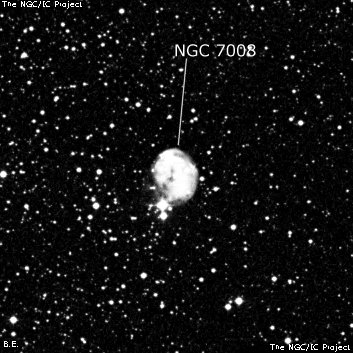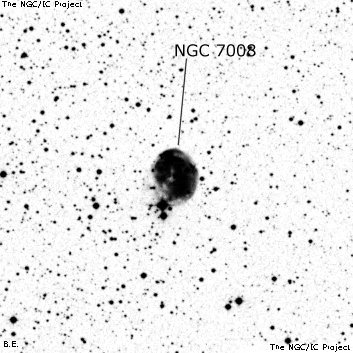NGC/IC Project Restoration Effort
(This is a very very beta version)
NGC7008


Basic Information
Location and Magnitude
Right Ascension: 21:0:32.8
Declination: +54:32:38
Constellation: CYG
Visual Magnitude: 10.7
Historic Information
Discoverer: Herschel W.
Year of discovery: 1787
Discovery aperture: 18.7
Observational
Summary description: cB, L, E 45┬░ ┬▒, r, ** att
Sub-type: PN
Steve's Notes
=====
NGC 7008
48" (10/24/14): We had a superb view of NGC 7008 unfiltered at 488x and 610x. This irregular, annular planetary extends ~1.5'x1.2 SSW-NNE with a roughly oval outline, except on the southwest end.╩ Several stars are involved or just off the edge, including h1606, a 9.6/11.7 pair at 19ė, which is just off the SSE edge.╩ A very bright, elongated knot is at the NNE edge of the rim. A larger elongated knot is just on its inside (towards the central star), with the pair of close knots virtually attached.╩ On the opposite SSW end is the next brightest region, extending nearly 45Ī along the rim.╩ This larger glow spreads irregularly into the darker center and dims.╩ Another brighter knot is on the WNW edge of the rim (probably K 4-44), just northeast of a mag 14 star that is close off the west edge.╩ Finally, another slightly brighter knot is at the east edge of the rim, close south of another mag 14 star on the northeast side.╩ The entire southwest side appears as if it was "nibbled" around the edges, as part of the outer edge is missing.╩ A mag 13.5 star sits in the center of the darker interior with the central "hole" darkest immediately east of the central star. Another darker region is in the southeast quadrant just north of h1606.
18" (9/10/07): The "Fetus Nebula" is a fascinating annular planetary, best viewed at high power. Using 452x the oval halo is elongated SSW-NNE, ~85"x65". The most striking feature is a bright, 25" knot on the NNE end that is irregular in surface brightness with a very small brighter condensation near its south end. The SW quadrant of the planetary is also brighter in an elongated region and it is weakest on the east and SE edge facing the wide double star off the south edge. In the darker center, a mag 13.5 central star is visible and a second fainter mag 14 star is near the NE edge. Also a mag 14 star is just off the west edge. NGC 7008 is situated just north of h1606, a mag 9.3/10.2 pair at 18" oriented N-S.
17.5" (6/28/00): this beautiful, highly structured PN is situated just north of a wide double star (9.2/10.5 at 18"). At 280x, the annular oval is elongated SSW-NNE, ~90"x65". A bright 30" irregular knot is prominent at the NE end. The SW end of the major axis has a fainter condensation and the rim is clearly dimmest near the double star. The mag 14 central star shines steadily as does a slightly fainter mag 14.5 on the NE edge. Just off the west edge is another 14th magnitude star. The darker center is faintly luminous and the surface brightness is irregular over the entire oval giving a mottled, wispy appearance.
13" (9/11/82): bright planetary with unusual structure and several stars involved. The striking complete annular ring is elongated SW-NE. A mag 14 central star mag is visible as well as a mag 14 star at the NE edge and a faint star is off the west edge. A small brighter knot marks the NE end. The planetary is located just north of h1606 = 9.3/10.5 at 18" separation.
8": unusual structure, curves and extends further south on the west side. A faint star is embedded.
80mm (9/10/07): the planetary was faintly visible in the finder at 25x using an OIII filter.



